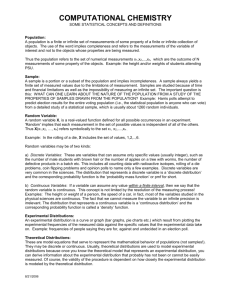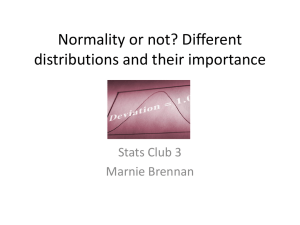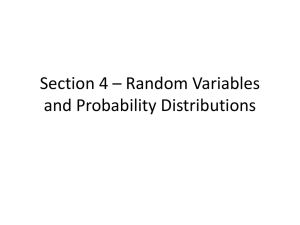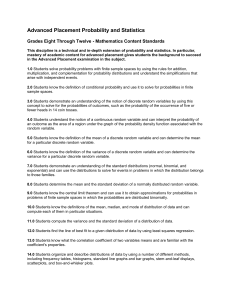Investigate a situation involving elements of chance The Conditions
advertisement
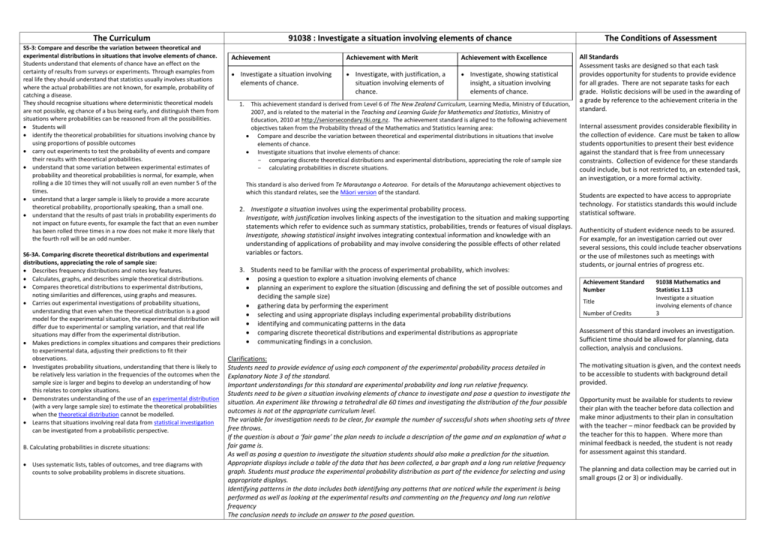
The Curriculum S5-3: Compare and describe the variation between theoretical and experimental distributions in situations that involve elements of chance. Students understand that elements of chance have an effect on the certainty of results from surveys or experiments. Through examples from real life they should understand that statistics usually involves situations where the actual probabilities are not known, for example, probability of catching a disease. They should recognise situations where deterministic theoretical models are not possible, eg chance of a bus being early, and distinguish them from situations where probabilities can be reasoned from all the possibilities. Students will identify the theoretical probabilities for situations involving chance by using proportions of possible outcomes carry out experiments to test the probability of events and compare their results with theoretical probabilities. understand that some variation between experimental estimates of probability and theoretical probabilities is normal, for example, when rolling a die 10 times they will not usually roll an even number 5 of the times. understand that a larger sample is likely to provide a more accurate theoretical probability, proportionally speaking, than a small one. understand that the results of past trials in probability experiments do not impact on future events, for example the fact that an even number has been rolled three times in a row does not make it more likely that the fourth roll will be an odd number. S6-3A. Comparing discrete theoretical distributions and experimental distributions, appreciating the role of sample size: Describes frequency distributions and notes key features. Calculates, graphs, and describes simple theoretical distributions. Compares theoretical distributions to experimental distributions, noting similarities and differences, using graphs and measures. Carries out experimental investigations of probability situations, understanding that even when the theoretical distribution is a good model for the experimental situation, the experimental distribution will differ due to experimental or sampling variation, and that real life situations may differ from the experimental distribution. Makes predictions in complex situations and compares their predictions to experimental data, adjusting their predictions to fit their observations. Investigates probability situations, understanding that there is likely to be relatively less variation in the frequencies of the outcomes when the sample size is larger and begins to develop an understanding of how this relates to complex situations. Demonstrates understanding of the use of an experimental distribution (with a very large sample size) to estimate the theoretical probabilities when the theoretical distribution cannot be modelled. Learns that situations involving real data from statistical investigation can be investigated from a probabilistic perspective. B. Calculating probabilities in discrete situations: Uses systematic lists, tables of outcomes, and tree diagrams with counts to solve probability problems in discrete situations. 91038 : Investigate a situation involving elements of chance Achievement Achievement with Merit Achievement with Excellence Investigate a situation involving Investigate, with justification, a Investigate, showing statistical elements of chance. 1. situation involving elements of chance. insight, a situation involving elements of chance. This achievement standard is derived from Level 6 of The New Zealand Curriculum, Learning Media, Ministry of Education, 2007, and is related to the material in the Teaching and Learning Guide for Mathematics and Statistics, Ministry of Education, 2010 at http://seniorsecondary.tki.org.nz. The achievement standard is aligned to the following achievement objectives taken from the Probability thread of the Mathematics and Statistics learning area: Compare and describe the variation between theoretical and experimental distributions in situations that involve elements of chance. Investigate situations that involve elements of chance: - comparing discrete theoretical distributions and experimental distributions, appreciating the role of sample size - calculating probabilities in discrete situations. This standard is also derived from Te Marautanga o Aotearoa. For details of the Marautanga achievement objectives to which this standard relates, see the Māori version of the standard. 2. Investigate a situation involves using the experimental probability process. Investigate, with justification involves linking aspects of the investigation to the situation and making supporting statements which refer to evidence such as summary statistics, probabilities, trends or features of visual displays. Investigate, showing statistical insight involves integrating contextual information and knowledge with an understanding of applications of probability and may involve considering the possible effects of other related variables or factors. 3. Students need to be familiar with the process of experimental probability, which involves: posing a question to explore a situation involving elements of chance planning an experiment to explore the situation (discussing and defining the set of possible outcomes and deciding the sample size) gathering data by performing the experiment selecting and using appropriate displays including experimental probability distributions identifying and communicating patterns in the data comparing discrete theoretical distributions and experimental distributions as appropriate communicating findings in a conclusion. Clarifications: Students need to provide evidence of using each component of the experimental probability process detailed in Explanatory Note 3 of the standard. Important understandings for this standard are experimental probability and long run relative frequency. Students need to be given a situation involving elements of chance to investigate and pose a question to investigate the situation. An experiment like throwing a tetrahedral die 60 times and investigating the distribution of the four possible outcomes is not at the appropriate curriculum level. The variable for investigation needs to be clear, for example the number of successful shots when shooting sets of three free throws. If the question is about a ‘fair game’ the plan needs to include a description of the game and an explanation of what a fair game is. As well as posing a question to investigate the situation students should also make a prediction for the situation. Appropriate displays include a table of the data that has been collected, a bar graph and a long run relative frequency graph. Students must produce the experimental probability distribution as part of the evidence for selecting and using appropriate displays. Identifying patterns in the data includes both identifying any patterns that are noticed while the experiment is being performed as well as looking at the experimental results and commenting on the frequency and long run relative frequency The conclusion needs to include an answer to the posed question. The Conditions of Assessment All Standards Assessment tasks are designed so that each task provides opportunity for students to provide evidence for all grades. There are not separate tasks for each grade. Holistic decisions will be used in the awarding of a grade by reference to the achievement criteria in the standard. Internal assessment provides considerable flexibility in the collection of evidence. Care must be taken to allow students opportunities to present their best evidence against the standard that is free from unnecessary constraints. Collection of evidence for these standards could include, but is not restricted to, an extended task, an investigation, or a more formal activity. Students are expected to have access to appropriate technology. For statistics standards this would include statistical software. Authenticity of student evidence needs to be assured. For example, for an investigation carried out over several sessions, this could include teacher observations or the use of milestones such as meetings with students, or journal entries of progress etc. Achievement Standard Number Title Number of Credits 91038 Mathematics and Statistics 1.13 Investigate a situation involving elements of chance 3 Assessment of this standard involves an investigation. Sufficient time should be allowed for planning, data collection, analysis and conclusions. The motivating situation is given, and the context needs to be accessible to students with background detail provided. Opportunity must be available for students to review their plan with the teacher before data collection and make minor adjustments to their plan in consultation with the teacher – minor feedback can be provided by the teacher for this to happen. Where more than minimal feedback is needed, the student is not ready for assessment against this standard. The planning and data collection may be carried out in small groups (2 or 3) or individually.

